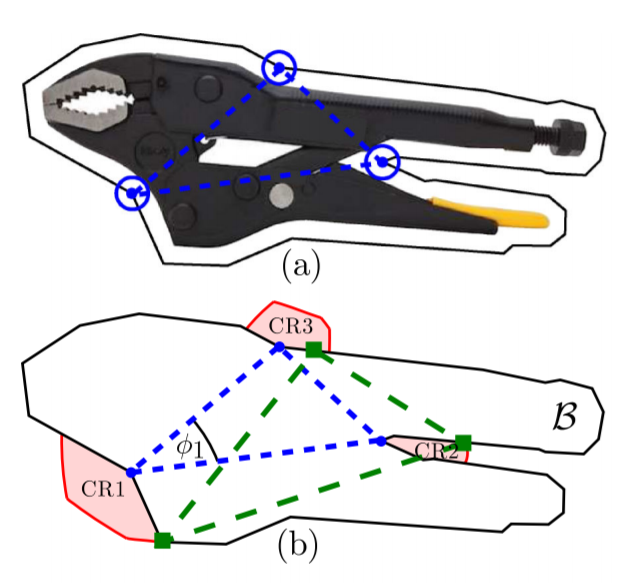Co-Authored Papers

The following papers were co-authored by me:
Caging polygonal objects using equilateral three-finger hands
Hallel A. Bunis, Elon D. Rimon, Yoav Golan, and Amir Shapiro. IEEE Robotics and Automation Letters 2, no. 3 (2017): 1672-1679.
Abstract—Multifinger caging offers a robust object grasping approach. While efficient computation of two-finger caging grasps is well developed, the computation of three-finger caging grasps has remained a challenging open problem. This letter considers the caging of polygonal objects with three-finger hands which maintain an equilateral triangle formation during the grasping process. While the c-space of such hands is four-dimensional (4-D), their contact space which represents all two and three finger contacts along the grasped object’s boundary forms a 2-D stratified manifold. The letter describes a caging graph that can be constructed in the hand’s relatively simple contact space. Starting from a desired immobilizing grasp of the object, the caging graph is searched for the largest finger opening that maintains a three-finger cage about the object. This finger opening determines the caging regions, and any equilateral finger placement within the caging regions guarantees a robust object grasping. The technique is illustrated with a detailed example and a video showing caging experiments with an equilateral robot hand.
Caging polygonal objects using formationally similar three-finger hands
Hallel A. Bunis, Elon D. Rimon, Yoav Golan, and Amir Shapiro. IEEE Robotics and Automation Letters 3, no. 4 (2018): 3271-3278.
Abstract—Caging offers a robust strategy for grasping objects with robot hands. This letter describes an efficient caging-to-grasping algorithm for polygonal objects using minimalistic three-finger robot hands. This letter describes how to cage and then grasp polygonal objects, using single actuator triangular three-finger formations, whose shape is determined by any desired immobilizing grasp of the polygonal object. While the hand’s configuration space is four-dimensional, the algorithm uses the hand’s two-dimensional contact space, which represents all two- and three-finger contacts along the grasped object boundary. This letter describes how the problem of computing the critical cage formation that allows the object to escape the hand is reduced to a search along a caging graph constructed in the hand’s contact space. Starting from a desired immobilizing grasp, the graph is searched for the critical cage formation, which is used to determine the caging regions surrounding the immobilizing grasp. Any three-finger placement within these regions guarantees robust object grasping. The technique is demonstrated with a detailed computational example and a video clip, which shows caging experiments with a single actuator three-finger robot hand.
SIMJig-Smart Independent Minimalist Jig
Gal Levi, Yoav Golan, and Amir Shapiro. IEEE Robotics and Automation Letters 7, no. 2 (2022): 3396-3403.
One of the most crucial parts of manufacturing is fixing the workpiece. Proper fixturing enables accurate machining, assembly, etching, etc. Most modern fixturing devices are static and difficult to adapt to varying workpieces. This letter introduces a new concept for a fixturing device–the SIMJig–that automatically adapts its structure to fix a given workpiece. Custom fitting the jig clamps to a workpiece can greatly improve the stability and accuracy of the manufacturing process. Reconfigurability is achieved by a unique clamp and gear design, as well as one of two optional external driving mechanisms. In total, the SIMJig only uses three actuators to control multiple clamps. The design of the SIMJig, as well as the two external drivers, are fully detailed. The method of operation is described, along with explanations of how the SIMJig is initialized. Two algorithms are presented that detail how the clamp configuration is derived from the workpiece model, and how the SIMJig derives the optimal reconfiguration scheme to achieve the clamp configuration. The SIMJig doubles as a turntable, which allows it to collaborate with robotic arms to vastly increase their workspace. This is illustrated for a notoriously difficult task of gasket insertion, using the SIMJig and two robotic arms.